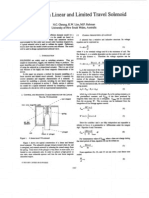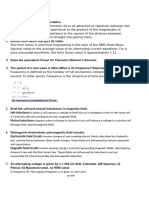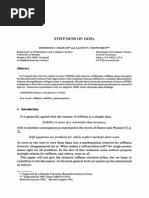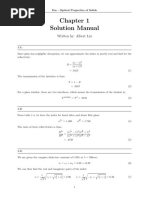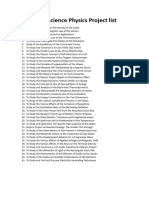Magnetic Circuits - Electromagnet
Magnetic Circuits - Electromagnet
Uploaded by
ilg1Copyright:
Available Formats
Magnetic Circuits - Electromagnet
Magnetic Circuits - Electromagnet
Uploaded by
ilg1Original Title
Copyright
Available Formats
Share this document
Did you find this document useful?
Is this content inappropriate?
Copyright:
Available Formats
Magnetic Circuits - Electromagnet
Magnetic Circuits - Electromagnet
Uploaded by
ilg1Copyright:
Available Formats
www.e-lee.
net
Magnetic circuits - electromagnet
Theme: Electrical Machines Chapter: Electromagnetic convertion Section: Type ressource: Lecture Virtual laboratory / Exercice MCQ
This lecture deals with the modelling of an electromagnet. This represents an opportunity for the introduction of Hopkinson's Law and the notion of magnetic circuit. prior knowledge: level: cycle 2 auxiliary resources: estimated time : author: Damien Grenier, Bruno Dehez realisation: Sophie Labrique translation: Bogdan Dumitrescu, Sergiu Ivanov
Resource developed with the financial support of the European Commission. The present document engages only the responsibility of the author(s). The Commission declines any responsibility that could follow from its use.
1. The importance of the magnetic circuit notion
The electromagnetic torque Tem or the electromagnetic force Fem provided by an electromagnetic convertor, can be expressed as being the partial derivative, depending on the rotor or the relay armature's position and on the magnetic co-energy, the latter being expressed according to the currents which flow through the differrent windings of the electromagnetic convertor. For a rotating convertor we can write :
For a lineary convertor:
The Wcmag magnetic co-energy can be calculated by integrating the fluxes expressions of the different windings depending on the flowing currents. For a n convertor we can write : in the case of a rotating convertor:
in the case of a lineary convertor:
In the writing of the flux-currents relations it is, in some cases, required the notion of magnetic circuit (as well as the notion of reluctance which is associated to it), because this notion allows the direct deduction of k(i1,i2,...,in, m) or k(i1,i2,...,in,xm) relations depending on the geometry of the studied device and on the permeability of the materials it is made of.
2. An example of magnetic circuit
To introduce the notion of magetic circuit, we will consider a reel with N turns reeled up round an annular core. (Figure 1).
Figure 1
3. Defining the integration contour for the application of Ampre's theorem
The magnetic field created by the current which flows through the reel, can be calculated applying Ampre's theorem on circular contours situated in sections parallel to the reel, sections whose centres are on the symmetry axis of the reel. (Figure 2).
Figure 2
4. The application of Ampre's theorem - emphasizing the magnetic circuit
Due to the symmetry, on the chosen integration contours, the induction field produced by / current that flows through the reel is always tangential at contour and has constant amplitude. The result is: If the contour has the radius R1 smaller than Ri (the internal radial of the annular core) - the 1 contour from figure 2) :
1
(1)
If the contour has the radius R2 bigger than Ri but smaller than Re (the external radius of the annular core) the 2 contour from figure 2):
(2)
finally, if the contour has the R3 bigger than Re - the
contour from figure 2):
(3)
where 0 represents the magnetic permeability of the vacuum and of the air, and represents the magnetic permeability of the material from which the annular core is made. It is ascertained that in any point outside the torus, the field is null. The entire flux induced by the current, circulates, therefore, within this volume, similar to an electrical circuit in which the power only flows through conductors. By analogy, we can define torus as being a magnetic circuit.
actually,for any contour situated in a plan which does intersect the reel.
5. Hopkinson's Law
If Ri 2i Re have similar values (meaning that the whirls are smaller than the medium radius Rm = (Ri+Re)/2), we can consider, without risking major errors, that all the integration contours situated within the torus have the approximately same Rmlenght. From here - the magnetic induction is constant in any point of a right section of the torus. As induction is, in any point, perpendicularly to the right section (because it is tangential to the in tegration contour), the flux through a right sectoin of the torus can be approximated:
(4)
where S is the right section of the torus. Combining equations (2) and (4) the result will be
(5)
with = 2. .Rm By noting and defining: F = N.I magnetomotive force expressed in ampere-turns; R= , reluctance of the magnetic circuit,
thus (5) could be write in this form:
(6)
This ecuation is also known as The Hopkinson's Law
6. Analogy between magnetic circuits/electrical circuits
Analogies between magnetic circuits and electrical circuits are easy to be made: The magnetic flux which flows through a magnetic circuit, corresponds to the electrical current / which flows through an electrical circuit; the magnetomotive force F, corresponds to the electromotive force U; reluctance R of a magnetic conductor by lenght, S section and permeability, corresponds to resistance R of an electrical conductor by lenght, S section and conductivity; we can write R = 2i R = ; finally Hopkison's Law F = R. corresponds to Ohm's Law U = R.I.
We can also define the permeance of a magnetic circuit P = 1/R, which corresponds to G = 1/R conductance of an electrical circuit. Magnetic circuit Flux ( ) Magnetomotive force(F) Reluctance (R) Permeance (P) Hopkison's Law (F = R. ) Electrical circuit Current (I) Electromotive force (U) Resistance (R) Conductance (G) Ohm's Law (U = R.I)
Analogy magnetic circuits / electrical circuits
7. Application for modelling an electromechanical converter
With the purpose of exemplification, we consider the application of the magnetic circuit notion for modelling the electromagnet in figure 3, for which we assume the same flux for both the ferromagnetic material and the electrical gap that separates them.
Figure 3
8. Defining the equivalent magnetic circuit
The analysis through the finite element method allows us to check the pertinency of the hypothesis, according to which the flux travels, mainly, through the ferromagnetic castings and the three electrical gap portions. Between two consecutive equiflux curves presented in figure 4, always travels the same quantity of magnetic flux. The hypothesis we considered, is reduced, in fact, to the dereliction of the leakage flux (the one that does not travel the air-gap), a flux which gets smaller as the size of the air-gap that must be traveled 2 gets smaller or as the relative permeability of the ferromagnetic material gets higher. .
Figure 4
Which leads us to consider that ferromagnetic materials are unsaturated.
9. The reduction of the equivalent magnetic circuit
Considering the symmetry of the device, we can study only one half of the magnetic circuit (Figure 5). The fluxes that flow through the two lateral columns are equal, each being half of the flux that flows through the central column, and the flux which flows half of this central column's section. (Figure 5).
Figure 5
10. Flux-current relation
Knowing the medium lenght and the perpendicular S section of the different elements of the magnetic circuit as well as the permeability of the material they are made of, the nine reluctances of this circuit can be calculated by using the general relation
If r is the relative permeability of the ferromagnetic material from which ( ) core is made of, permeability supposing to be constant whatever the value of the current (unsaturated circuit), we can calculate:
The flux which flows through each of the two circuit branches (circuit equal to half of the total flux) can be, then, written as follows:
(7)
It is rather noteable that if the total lenght of the magnetic circuit is negligible in proportion to the product of r and the total lenght of the air-gap portions, in order to obtain flux-current relation, it can be approximated, without making significant errors, that the total reluctance of the magnetic circuit is 3 equal to that of the electrical gap portions . For a relative r permeability higher than 1000 and for values of the air-gap lower than 1mm, this approximation stays valid as long as the total lenght of the circuit remains lower than 2m.
3
In fact, this kind of simplification is generally adopted in modelling the electromechanical converters , assuming that the permeability of the ferromagnetic materials they are made of, is infinite.
11. The calculus of the magnetic co-energy and attraction force
The flux induced in the N whirls of the reel are expressed : , in which according to (7),
The magnetic co-energy is then
The attraction force between the two elements of the ferromagnetic core is finally expressed:
It is in inverse ratio to e, having a maximum equal to:
for
4
which is, however, equal to magnetic energy, as presented in 2.4.3 of the book because, assuming a constant r, we face the case where the flux-current relations are linear.
You might also like
- Modelling A Linear and Limited Travel SolenoidNo ratings yetModelling A Linear and Limited Travel Solenoid6 pages
- EE352 Chapter#2 Electromagnetism and Magnetic Curcuits100% (1)EE352 Chapter#2 Electromagnetism and Magnetic Curcuits55 pages
- EE352 Chapter #2 Basic Laws of Electromagnetism and Magnetic CircuitsNo ratings yetEE352 Chapter #2 Basic Laws of Electromagnetism and Magnetic Circuits25 pages
- Electromechanical Energy Conversion - LN 1No ratings yetElectromechanical Energy Conversion - LN 123 pages
- Unit I (Magnetic Field and Circuits - Electromagnetic Force and Torque)No ratings yetUnit I (Magnetic Field and Circuits - Electromagnetic Force and Torque)43 pages
- Magnetic Circuits: - Series Magnetic Circuit - Parallel Magnetic Circuit - Series-Parallel Magnetic Circuits100% (1)Magnetic Circuits: - Series Magnetic Circuit - Parallel Magnetic Circuit - Series-Parallel Magnetic Circuits37 pages
- 1.1 Review of Magnetic Circuits and Its PropertiesNo ratings yet1.1 Review of Magnetic Circuits and Its Properties65 pages
- Magnetic Circuits and magnetic MaterialsNo ratings yetMagnetic Circuits and magnetic Materials31 pages
- Curl of A Magnetic Field: J Is The Current Density, Which Is TheNo ratings yetCurl of A Magnetic Field: J Is The Current Density, Which Is The5 pages
- FE-Modelling of Induction Tool Responses: F Iii: GNo ratings yetFE-Modelling of Induction Tool Responses: F Iii: G4 pages
- UNIT-1 To 5-19EE1ICBEE Notes - 2020 Batch-MinNo ratings yetUNIT-1 To 5-19EE1ICBEE Notes - 2020 Batch-Min149 pages
- Study of Wireless Power Transfer by Induction Technique: Amit Kumar, Shubhajit Jana, Reshmi ChandraNo ratings yetStudy of Wireless Power Transfer by Induction Technique: Amit Kumar, Shubhajit Jana, Reshmi Chandra6 pages
- Chapter One Electromagnetic Principle-1No ratings yetChapter One Electromagnetic Principle-168 pages
- Physics Electric Current Magnetic Field Jean-Baptiste Biot Félix SavartNo ratings yetPhysics Electric Current Magnetic Field Jean-Baptiste Biot Félix Savart5 pages
- 11.1 - Introduction: Inductors Have A Number of Response Characteristics100% (1)11.1 - Introduction: Inductors Have A Number of Response Characteristics31 pages
- Current Density - Wikipedia, The Free EncyclopediaNo ratings yetCurrent Density - Wikipedia, The Free Encyclopedia6 pages
- Intensity of Electromagnetic Waves as a Function of Frequency, Source Distance and Aperture AngleFrom EverandIntensity of Electromagnetic Waves as a Function of Frequency, Source Distance and Aperture AngleNo ratings yet
- Framework Forecasting Self-Organizing: Quality Models UsingNo ratings yetFramework Forecasting Self-Organizing: Quality Models Using6 pages
- Home Automation Using Internet of Things PDFNo ratings yetHome Automation Using Internet of Things PDF6 pages
- Object Counting and Density Calculation Using MatlabNo ratings yetObject Counting and Density Calculation Using Matlab46 pages
- Design For Visually Impaired To Work at Industry Using RFID TechnologyNo ratings yetDesign For Visually Impaired To Work at Industry Using RFID Technology5 pages
- Coordination of Suck-Swallow and Swallow Respiration in Preterm InfantsNo ratings yetCoordination of Suck-Swallow and Swallow Respiration in Preterm Infants8 pages
- Genetic Algorithms For Fuzzy Control: Offline System Development and ApplicationNo ratings yetGenetic Algorithms For Fuzzy Control: Offline System Development and Application16 pages
- Expressed in The Hairer and Wanner 2) ,: Stiff Equations Are Problems For Which Explicit Methods Don'tNo ratings yetExpressed in The Hairer and Wanner 2) ,: Stiff Equations Are Problems For Which Explicit Methods Don't19 pages
- The Physical and Mathematical Modelling of Gas Stirred Ladle Systems PDFNo ratings yetThe Physical and Mathematical Modelling of Gas Stirred Ladle Systems PDF20 pages
- (MCQs) Basic Physics (311305) - All Three Chapters CombineNo ratings yet(MCQs) Basic Physics (311305) - All Three Chapters Combine45 pages
- Problems and Solutions in A Graduate Course in Classical ElectrodynamicsNo ratings yetProblems and Solutions in A Graduate Course in Classical Electrodynamics64 pages
- 1 - Steel Design by Advanced Analysis. Material Modeling and Strain Limits Gardner Et AlNo ratings yet1 - Steel Design by Advanced Analysis. Material Modeling and Strain Limits Gardner Et Al7 pages
- Lecture Planner : Good Morning (Physics) Series || Prachand NEET 2025No ratings yetLecture Planner : Good Morning (Physics) Series || Prachand NEET 20252 pages
- Shakedown and Plastic Design of Steel StructuresNo ratings yetShakedown and Plastic Design of Steel Structures2 pages
- Computers and Geotechnics: H. Elsafti, H. OumeraciNo ratings yetComputers and Geotechnics: H. Elsafti, H. Oumeraci25 pages
- Strain-Based Fracture Mechanics Analysis of Pipelines: Icasi/Xx-XxxNo ratings yetStrain-Based Fracture Mechanics Analysis of Pipelines: Icasi/Xx-Xxx6 pages
- Wind and Temperature Effects On Sound PropagationNo ratings yetWind and Temperature Effects On Sound Propagation8 pages
- Seismic Analysis of TBM Tunnel, Cairo Metro Line IiiNo ratings yetSeismic Analysis of TBM Tunnel, Cairo Metro Line Iii8 pages
- Solenoid Actuators: Theory and Computational MethodsFrom EverandSolenoid Actuators: Theory and Computational Methods
- EE352 Chapter#2 Electromagnetism and Magnetic CurcuitsEE352 Chapter#2 Electromagnetism and Magnetic Curcuits
- EE352 Chapter #2 Basic Laws of Electromagnetism and Magnetic CircuitsEE352 Chapter #2 Basic Laws of Electromagnetism and Magnetic Circuits
- Unit I (Magnetic Field and Circuits - Electromagnetic Force and Torque)Unit I (Magnetic Field and Circuits - Electromagnetic Force and Torque)
- Magnetic Circuits: - Series Magnetic Circuit - Parallel Magnetic Circuit - Series-Parallel Magnetic CircuitsMagnetic Circuits: - Series Magnetic Circuit - Parallel Magnetic Circuit - Series-Parallel Magnetic Circuits
- 1.1 Review of Magnetic Circuits and Its Properties1.1 Review of Magnetic Circuits and Its Properties
- Curl of A Magnetic Field: J Is The Current Density, Which Is TheCurl of A Magnetic Field: J Is The Current Density, Which Is The
- FE-Modelling of Induction Tool Responses: F Iii: GFE-Modelling of Induction Tool Responses: F Iii: G
- Study of Wireless Power Transfer by Induction Technique: Amit Kumar, Shubhajit Jana, Reshmi ChandraStudy of Wireless Power Transfer by Induction Technique: Amit Kumar, Shubhajit Jana, Reshmi Chandra
- Physics Electric Current Magnetic Field Jean-Baptiste Biot Félix SavartPhysics Electric Current Magnetic Field Jean-Baptiste Biot Félix Savart
- 11.1 - Introduction: Inductors Have A Number of Response Characteristics11.1 - Introduction: Inductors Have A Number of Response Characteristics
- Current Density - Wikipedia, The Free EncyclopediaCurrent Density - Wikipedia, The Free Encyclopedia
- A New Approach to the Quantum Theory: Think Physics, #7From EverandA New Approach to the Quantum Theory: Think Physics, #7
- Don't Burn Your Brain: EMR, RF Radiation & YouFrom EverandDon't Burn Your Brain: EMR, RF Radiation & You
- Intensity of Electromagnetic Waves as a Function of Frequency, Source Distance and Aperture AngleFrom EverandIntensity of Electromagnetic Waves as a Function of Frequency, Source Distance and Aperture Angle
- On the effect of electric and magnetic fields on spectral linesFrom EverandOn the effect of electric and magnetic fields on spectral lines
- Framework Forecasting Self-Organizing: Quality Models UsingFramework Forecasting Self-Organizing: Quality Models Using
- Object Counting and Density Calculation Using MatlabObject Counting and Density Calculation Using Matlab
- Design For Visually Impaired To Work at Industry Using RFID TechnologyDesign For Visually Impaired To Work at Industry Using RFID Technology
- Coordination of Suck-Swallow and Swallow Respiration in Preterm InfantsCoordination of Suck-Swallow and Swallow Respiration in Preterm Infants
- Genetic Algorithms For Fuzzy Control: Offline System Development and ApplicationGenetic Algorithms For Fuzzy Control: Offline System Development and Application
- Expressed in The Hairer and Wanner 2) ,: Stiff Equations Are Problems For Which Explicit Methods Don'tExpressed in The Hairer and Wanner 2) ,: Stiff Equations Are Problems For Which Explicit Methods Don't
- The Physical and Mathematical Modelling of Gas Stirred Ladle Systems PDFThe Physical and Mathematical Modelling of Gas Stirred Ladle Systems PDF
- (MCQs) Basic Physics (311305) - All Three Chapters Combine(MCQs) Basic Physics (311305) - All Three Chapters Combine
- Problems and Solutions in A Graduate Course in Classical ElectrodynamicsProblems and Solutions in A Graduate Course in Classical Electrodynamics
- 1 - Steel Design by Advanced Analysis. Material Modeling and Strain Limits Gardner Et Al1 - Steel Design by Advanced Analysis. Material Modeling and Strain Limits Gardner Et Al
- Lecture Planner : Good Morning (Physics) Series || Prachand NEET 2025Lecture Planner : Good Morning (Physics) Series || Prachand NEET 2025
- Computers and Geotechnics: H. Elsafti, H. OumeraciComputers and Geotechnics: H. Elsafti, H. Oumeraci
- Strain-Based Fracture Mechanics Analysis of Pipelines: Icasi/Xx-XxxStrain-Based Fracture Mechanics Analysis of Pipelines: Icasi/Xx-Xxx
- Seismic Analysis of TBM Tunnel, Cairo Metro Line IiiSeismic Analysis of TBM Tunnel, Cairo Metro Line Iii


